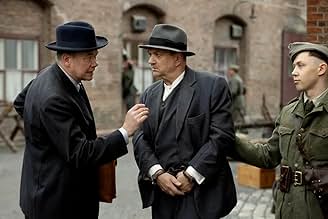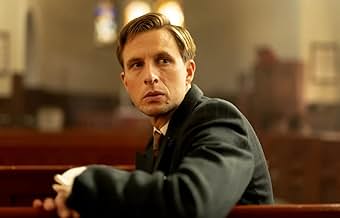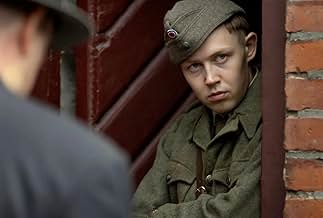Quislings siste dager
- 2024
- 2h 26m
IMDb RATING
7.1/10
1.3K
YOUR RATING
Five years of occupation during WW2 ends in Norway. Vidkun Quisling is in prison for treason and is to be held accountable for his actions. Can a priest help him find peace of mind? Can the ... Read allFive years of occupation during WW2 ends in Norway. Vidkun Quisling is in prison for treason and is to be held accountable for his actions. Can a priest help him find peace of mind? Can the traitor with big thoughts about himself repent?Five years of occupation during WW2 ends in Norway. Vidkun Quisling is in prison for treason and is to be held accountable for his actions. Can a priest help him find peace of mind? Can the traitor with big thoughts about himself repent?
- Director
- Writers
- Stars
Gard B. Eidsvold
- Vidkun Quisling
- (as Gard Bjørnstjerne Eidsvold)
Johan Ivarson
- Politibetjent #2
- (as Johan Ivarsson)
- Director
- Writers
- All cast & crew
- Production, box office & more at IMDbPro
Featured reviews
Unlike Sweden Norway has a limited film history. Little was heard about Erik Skjoldbjærg after "Insomnia" (1997) and Thea Hvistendahl ("Handling the undead", 2024) still has to prove herself. The only two vested Norwegian directors seem to be Joachim Trier ("Thelma, 2017 and "The worst person in the world", 2021) and Erik Poppe.
"Quisling the final days" is the last film in a trilogy Poppe made about right wing extremist ideology.
"The King's choice" (2016) is about the resistance of King Haakon VII of Norway against the Nazi's in the Second World War. In other words the film is about an historical hero.
"Utoya, 22 july" (2018) is about the terrorist attack on a childrens summer camp in 2011 by Anders Breivik. It is about current right wing extrimism and is told from the point of view of a victim.
"Quisling, the final days" (2024) is again situated in (or more precisely just after) the Second World War. It is about the Prime Minister of Norway who collaborated with the Nazi's until the end of the war. The main character of the story this time is a villain. In most Second World War movies the German's are the ultimate villians, but "Quisling, the final days" is about a collaborator for a change.
The addition "final days" in the title of the movie indicates that this is not really a biopic. The film starts at the end of the Second World War with the arrest of Quisling. The film essentialy is about Quisling meditating about his deeds during his trial. He does so together with the priest Peder Olsen, who is assigned to him for the salavation of his soul (not his body!).
In effect Peder Olsen is just as much a main character as Quisling is. The essence of the film is their relationship and their communication, mostly about religion. With this Poppe firmly stands in the tradition of Ingmar Bergman. The film reminded me very much of "Winter light" (1963, Ingmar Bergman). In "Winter light" a priest doesn't manage to alleviate the fears and doubts of his parishioner. In "Quisling, the final days" on the other hand the priest doesn't manage to sow any doubts in the character of Quisling until almost the very (strong and surprising) end.
Quisling stubbornly keeps beleiving that he did nothing wrong and that he saved Norway from Bolshevik Russia. Years ago Quisling had witnessed the famine Stalin created willfully in Ukraine. The rule of thumb "the enemy of my enemy is my friend" (wrong as always) drove him in the corner of the Nazi ideology.
Coincidentally, "Quisling, the final days" was released in more or less the same period as "Riefenstahl" (2024, Andres Veiel). Whereas Leni Riefenstahl downplayed her relationship with the Nazi's after the Second World War, Quisling almost seems proud of it.
Cinema is visual storytelling. In "Quisling, the final days" Poppe uses a color palette in which green and red are very dominant colors. It creates an uncanny mood. In "Beanpole" (2019, Kantemir Balagov) the same colors were used to create the same effect.
"Quisling the final days" is the last film in a trilogy Poppe made about right wing extremist ideology.
"The King's choice" (2016) is about the resistance of King Haakon VII of Norway against the Nazi's in the Second World War. In other words the film is about an historical hero.
"Utoya, 22 july" (2018) is about the terrorist attack on a childrens summer camp in 2011 by Anders Breivik. It is about current right wing extrimism and is told from the point of view of a victim.
"Quisling, the final days" (2024) is again situated in (or more precisely just after) the Second World War. It is about the Prime Minister of Norway who collaborated with the Nazi's until the end of the war. The main character of the story this time is a villain. In most Second World War movies the German's are the ultimate villians, but "Quisling, the final days" is about a collaborator for a change.
The addition "final days" in the title of the movie indicates that this is not really a biopic. The film starts at the end of the Second World War with the arrest of Quisling. The film essentialy is about Quisling meditating about his deeds during his trial. He does so together with the priest Peder Olsen, who is assigned to him for the salavation of his soul (not his body!).
In effect Peder Olsen is just as much a main character as Quisling is. The essence of the film is their relationship and their communication, mostly about religion. With this Poppe firmly stands in the tradition of Ingmar Bergman. The film reminded me very much of "Winter light" (1963, Ingmar Bergman). In "Winter light" a priest doesn't manage to alleviate the fears and doubts of his parishioner. In "Quisling, the final days" on the other hand the priest doesn't manage to sow any doubts in the character of Quisling until almost the very (strong and surprising) end.
Quisling stubbornly keeps beleiving that he did nothing wrong and that he saved Norway from Bolshevik Russia. Years ago Quisling had witnessed the famine Stalin created willfully in Ukraine. The rule of thumb "the enemy of my enemy is my friend" (wrong as always) drove him in the corner of the Nazi ideology.
Coincidentally, "Quisling, the final days" was released in more or less the same period as "Riefenstahl" (2024, Andres Veiel). Whereas Leni Riefenstahl downplayed her relationship with the Nazi's after the Second World War, Quisling almost seems proud of it.
Cinema is visual storytelling. In "Quisling, the final days" Poppe uses a color palette in which green and red are very dominant colors. It creates an uncanny mood. In "Beanpole" (2019, Kantemir Balagov) the same colors were used to create the same effect.
Quislings siste dager attempts to delve into the psyche of one of Norway's most infamous historical figures, yet it struggles to bring his inner turmoil to life in a truly cinematic way. The film presents a compelling subject-Quisling's fears, loathing, and psychological unraveling in his final days-but fails to fully capitalize on its potential for visual storytelling.
While the script aims for introspection, the execution leans too heavily on dialogue, making it feel more like a staged theater production than an immersive film. The editing lacks dynamism, often slowing the pacing rather than enhancing the tension or emotional weight of the story. Likewise, the cinematography is competent but uninspired, doing little to elevate the film beyond a functional historical reenactment.
The performances, while dedicated, are hampered by the film's restrained approach. Quisling's descent into paranoia and despair should have been an intense and harrowing experience, but the film's stylistic choices mute much of that potential. There are moments where the film hints at something deeper-a fleeting glance, a subtle hesitation-but these are often undercut by the theatrical blocking and over-reliance on exposition.
While the script aims for introspection, the execution leans too heavily on dialogue, making it feel more like a staged theater production than an immersive film. The editing lacks dynamism, often slowing the pacing rather than enhancing the tension or emotional weight of the story. Likewise, the cinematography is competent but uninspired, doing little to elevate the film beyond a functional historical reenactment.
The performances, while dedicated, are hampered by the film's restrained approach. Quisling's descent into paranoia and despair should have been an intense and harrowing experience, but the film's stylistic choices mute much of that potential. There are moments where the film hints at something deeper-a fleeting glance, a subtle hesitation-but these are often undercut by the theatrical blocking and over-reliance on exposition.
It probably was about time that Norwegian cinema tackled this elephant in the room and made a biopic on Vidkun Quisling, the man who appointed himself Minister President and collaborated with the Nazis during the German occupation of Norway between 1940 and 1945, and paid the ultimate price for his actions when in October 1945 he became the last person to be executed in Norway. The director is Erik Poppe, who has handled Norwegian national traumas skilfully before, notably with Utøya 22. Juli in 2018, and he manages to portray Quisling with a fairly dignified level of balance, even if his dissection becomes lingering at times. The running time most certainly could have been trimmed a little; there are a few too many meetings behind closed doors. And although there is a disruptive dissonance between Eidsvold's imitative rendition of Quisling's intonation and demeanour on the one side, and Danielsen Lie's overly modern approach and delivery, their final scene together ultimately does evoke some of the intended emotion and bond between their two characters. With beautiful CGI recreations of 1940s Oslo which elevate the overall impression.
An absolute masterpiece from start to finish! The acting was nothing short of brilliant, with each performance delivering a depth and authenticity that truly brought the characters to life. The slower pacing worked beautifully, giving the audience time to fully immerse themselves in the story and appreciate every subtle nuance.
The film provided an insightful and thought-provoking portrayal of Quisling, his wife, and Peder the priest. It struck the perfect balance between personal drama and historical context, offering a unique perspective on this dark chapter of history. The restrained use of CGI was impeccable, enhancing the scenes without ever detracting from the emotional weight of the performances.
The storyline was gripping, full of tension and reflection, leaving you to ponder the moral complexities long after the credits rolled. It didn't rely on heavy-handed depictions of brutality, but rather focused on the psychological and emotional layers, making it all the more impactful.
As with many great Norwegian films, the atmosphere was dark and intimate, and the smaller cast only added to its charm. Each character felt fully realized, contributing to a rich and immersive viewing experience. A truly exceptional film that showcases the best of what Norwegian cinema has to offer.
The film provided an insightful and thought-provoking portrayal of Quisling, his wife, and Peder the priest. It struck the perfect balance between personal drama and historical context, offering a unique perspective on this dark chapter of history. The restrained use of CGI was impeccable, enhancing the scenes without ever detracting from the emotional weight of the performances.
The storyline was gripping, full of tension and reflection, leaving you to ponder the moral complexities long after the credits rolled. It didn't rely on heavy-handed depictions of brutality, but rather focused on the psychological and emotional layers, making it all the more impactful.
As with many great Norwegian films, the atmosphere was dark and intimate, and the smaller cast only added to its charm. Each character felt fully realized, contributing to a rich and immersive viewing experience. A truly exceptional film that showcases the best of what Norwegian cinema has to offer.
Excellent acting but the film moved along too slow. Dialogue snooze fest! Felt like a small stage event. Storyline was good but could have included a bit more of Quisling and the Nazi parties brutality toward the Norwegian people.
An interesting look at Quisling and his wife as well as Peder the priest. Cgi was good and again great acting.
The film leaves you wondering other than the murders at Trandumskogen pow camp what else horrible did he do to deserve the death penalty.
As typical with Norwegian films the storyline is dark, and there are only a handful of actors. Maybe spoiled by Spielberg but here there could have more depth and more actors.
An interesting look at Quisling and his wife as well as Peder the priest. Cgi was good and again great acting.
The film leaves you wondering other than the murders at Trandumskogen pow camp what else horrible did he do to deserve the death penalty.
As typical with Norwegian films the storyline is dark, and there are only a handful of actors. Maybe spoiled by Spielberg but here there could have more depth and more actors.
Did you know
- TriviaThe house depicted as Vidkun Quisling's residence in the series is the actual Villa Grande, located on Bygdøy in Oslo, Norway. During World War II, Quisling occupied Villa Grande, which he renamed «Gimle». After the war, the property served various purposes, including housing the Norwegian Center for Holocaust and Minority Studies (HL-senteret) since 2005. Therefore, the building still exists and is publicly owned, functioning as a center dedicated to Holocaust and minority studies.
- How long is Quisling: The Final Days?Powered by Alexa
Details
- Release date
- Countries of origin
- Languages
- Also known as
- Quisling: The Final Days
- Production companies
- See more company credits at IMDbPro
Box office
- Gross worldwide
- $2,321,812
- Runtime2 hours 26 minutes
- Color
- Aspect ratio
- 1.85 : 1
Contribute to this page
Suggest an edit or add missing content



























